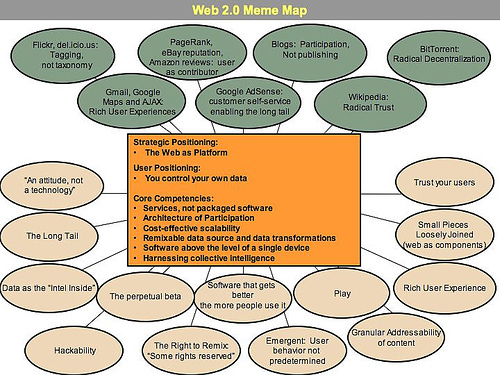There has been lots of discussion about Tim O’Reilly’s Web2MemeMap.
This is a nice graphical representation of what is happening in this next wave of the Internet. As an add-on to this, I thought I would compare and contrast some differences, all quite obvious, with the first euphoric Internet wave. I have shared many of these thoughts in earlier posts like "The web-based platform" last October and "Web-based businesses circa 2004."
| Web 1999/2000 | Web 2005 | |
| Critical Mass | 12.8m | 209m |
| GoToMarket Philosophy | If you build it, they will come | Release early and release often |
| Tech platform |
Sun, Oracle, EMC= Big $$$ |
LAMP, open source, Intel, clusters, JBOD |
| Philosophy | Closed | Open, APIs and data sharing |
| Customer acquisition | Spend $$$, advertising | Spend nothing, word of mouth rules |
| Milestone for VC Funding | No users, great idea | Lots of users and rich interaction |
| $ used for | Building product, marketing $ to acquire users | Scaling back end, adding more features/functionality |
| First Round Funding | VC – $5-10mm | Angels – $0-2mm |
| Second Round Funding | VC – $10-20mm | VC – $5 or trade sale |
| Business Models | Unproven | Proven |
So as you can see, there are more sophisticated users, it costs significantly less to launch a new service/product, and many of the business models are proven to reach profitability. In other words, these business models are quite capital efficient. It is no wonder why VCs are quite excited about next generation web companies. All that being said, I, like others, worry about believing all of our own hype, and moving ourselves to another bubble. As you see from Tim’s map and my table above, if it costs less to build and launch a company, then the barriers to entry must be lower as well. What this really means is that building a sustainable competitive advantage in this new open world means leveraging network effects to foster loyalty, community, and collaboration. In most cases this will be enough to create lots of value. In other cases like Friendster vs.MySpace it shows that this network effect can also be fleeting.
One other point to consider with all of this is the significant changes ahead in the enterprise. Many of the points in the map above fit consumer-facing services. With the proliferation of broadband and the thought that the consumer is also an enterprise user, we must be cognizant of the many opportunities for web-based services to be brought into the corporation from the ground-up. Everything we did in Windows and Office and other enterprise apps 5 years ago can be done through a browser/web with Salesforce.com, Skype, and web-based email and calendaring. We are clearly not there yet, but this will happen. In addition, as enterprises move to a world where they must support multiple users and devices on-demand, they will need to buy new software and infrastructure to manage this new complexity. So as you can tell, I am quite excited about the opportunities as the web becomes a more robust platform and a gateway to deliver rich applications, but at the same time I express caution because I do not want to want to make the same mistakes we did in years past.
